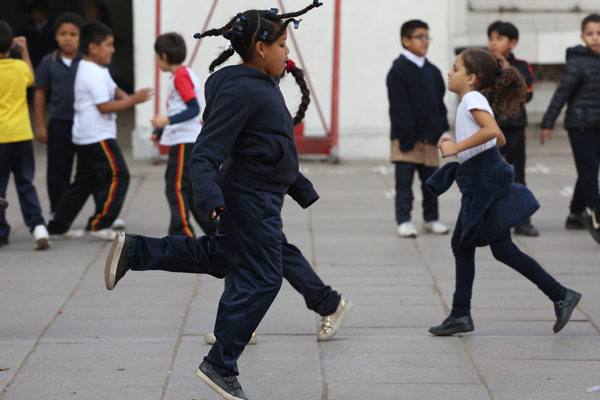Afrodescendent childhood in Colombia

DORA INÉS VIVANCO JULIO
Master in Development Management, Consultant, Researcher
"Mamá yo quiero salir a jugar con mis amigos (…)
A la lleva y al quemado, jugando mamá jugando
Jugué a la gallina ciega, jugando mamá jugando”.
Zully Murillo, Jugando
The orality of Afro-Colombian population gathers traditions with which boys and girls of African descent have grown up who, from different regions, share symbolic elements and stories that denote the connection with rivers and seas around which, centuries ago, cimarron ancestors [1] constituted Palenques as territories free from slave trade. These territories still retain great wealth and natural resources of which Afrodescendent populations are safeguarded given history, spirituality and the link with their ancestors. This wisdom has been transmitted for generations through the stories of the elderly, traditional medicine, midwifery (recognized today as cultural and intangible heritage), Creole languages (Creole and Palenquero) and children’s rounds, lullabies and praise that survive in the extended families conformed by parents, grandparents, cousins, uncles, compadres (pals), neighbors and friends who weave bonds of brotherhood and solidarity throughout life.
But these extended families have been changing. Although the processes of survival and resistance have made it possible to maintain traditions and defend the territory, violence due to armed conflict has led to exploitation, dispossession and forced displacement. Children and young people of African descent have been disproportionately affected. As recognized by the Monitoring Commission of Order 005 of Judgment T-025 of the Constitutional Court, the Afrodescent population represents 22.5% (with a sub-registration of approximately 12%) of the total number of victims - which are already 8.8 million to 2019- and about 52% of this total are children and adolescents. To this date, there is no ethnic disaggregation of this figure (CODHES, 2013). The 2005 census figures reported by DANE indicate that Afro-Colombians were 10.6% of the Colombian population (DANE, s/f).[2]
With the dispossession of collective territories, girls and boys of African descent experience changes in their lifestyle and arrive in cities where their culture is not understood and their ethnicity (skin color, curly hair and dialects) is not recognized as wealth, but as a differentiating factor that is emphasized from rejection, segregation and racist behaviors. This situation is not only experienced by those who move, but also by those born in those cities. It is also observed that maternal-child malnutrition, de-schooling, armed child recruitment and psychosocial effects have increased. Although in Colombia ethnic and cultural diversity is recognized as a fundamental principle of the Social and Democratic State of Law against the stigmatization of customs, ancestral knowledge and culture, there is a loss of identity. Therefore, collective memory has weakened and is still invisible in the nation’s history construction.
Among the great challenges of Colombia to recognize and guarantee the rights of children of African descent, we can mention:
- Implement a structural action plan for the International Decade for People of African Descent.
- Ensure statistical figures are ethnically disaggregated and include intersectoral analysis.
- Deploy public policies with an Afro-ethnic approach, with indicators, goals and budgets.
- Strengthen the institutional structure with provision and inter-organizational networks with different Afro-Colombian organizational expressions, guaranteeing its governance as an ethnic people.
- Promote ethnic self-recognition and the empowerment of the collective rights of children of African descent (ILO Convention 169). The work of the National Conference of Afro-Colombian Organizations (CNOA), that has outlined guidelines and influenced the national agenda for the integral protection of the rights of Afro children and has co-created recreational and educational material with children, stands out.
- The 2030 agenda marks a horizon. It is essential to open spaces and be bridges for Afrodescendent children and young people to be managers of their own development, so that the effective enjoyment of their rights ceases to be a privilege.
Bibliography
CODHES (Consultoría para los Derechos Humanos y el Desplazamiento) (2013), Reparación integral a pueblos y comunidades afrocolombianas. Informe sobre el proceso de consulta previa y construcción del Decreto Ley 4635 de 2011, relativo a la asistencia, atención y reparación integral y restitución de tierras de las víctimas de comunidades negras, afrocolombianas, raizales y palenqueras. Documento CODHES N° 27, Bogotá. Available [on line]
DANE (Departamento Administrativo Nacional de Estadística) (s/f), “La visibilización estadística de los grupos étnicos colombianos”, Bogotá. Available [on line]
ECLAC/PAHO/UNFPA/RMAAD (Economic Commission for Latin America and the Caribbean/Panamerican Health Organization/United Nations Population Fund/Red de Mujeres Afrolatinoamericanas, Afrocaribeñas y de la Diáspora)(2017), Situación de las personas afrodescendientes en América Latina y desafíos de políticas para la garantía de sus derechos (LC/TS.2017/121), Santiago.